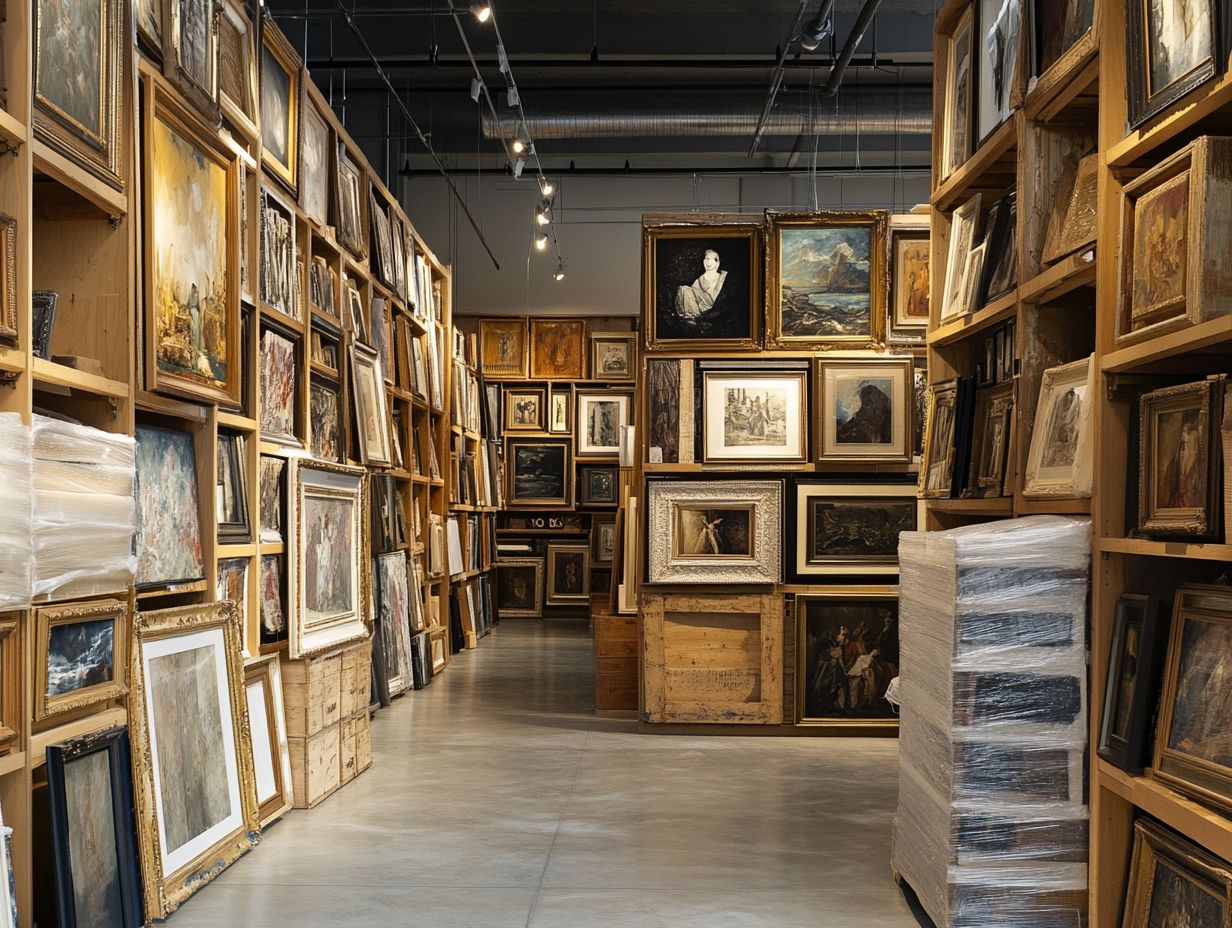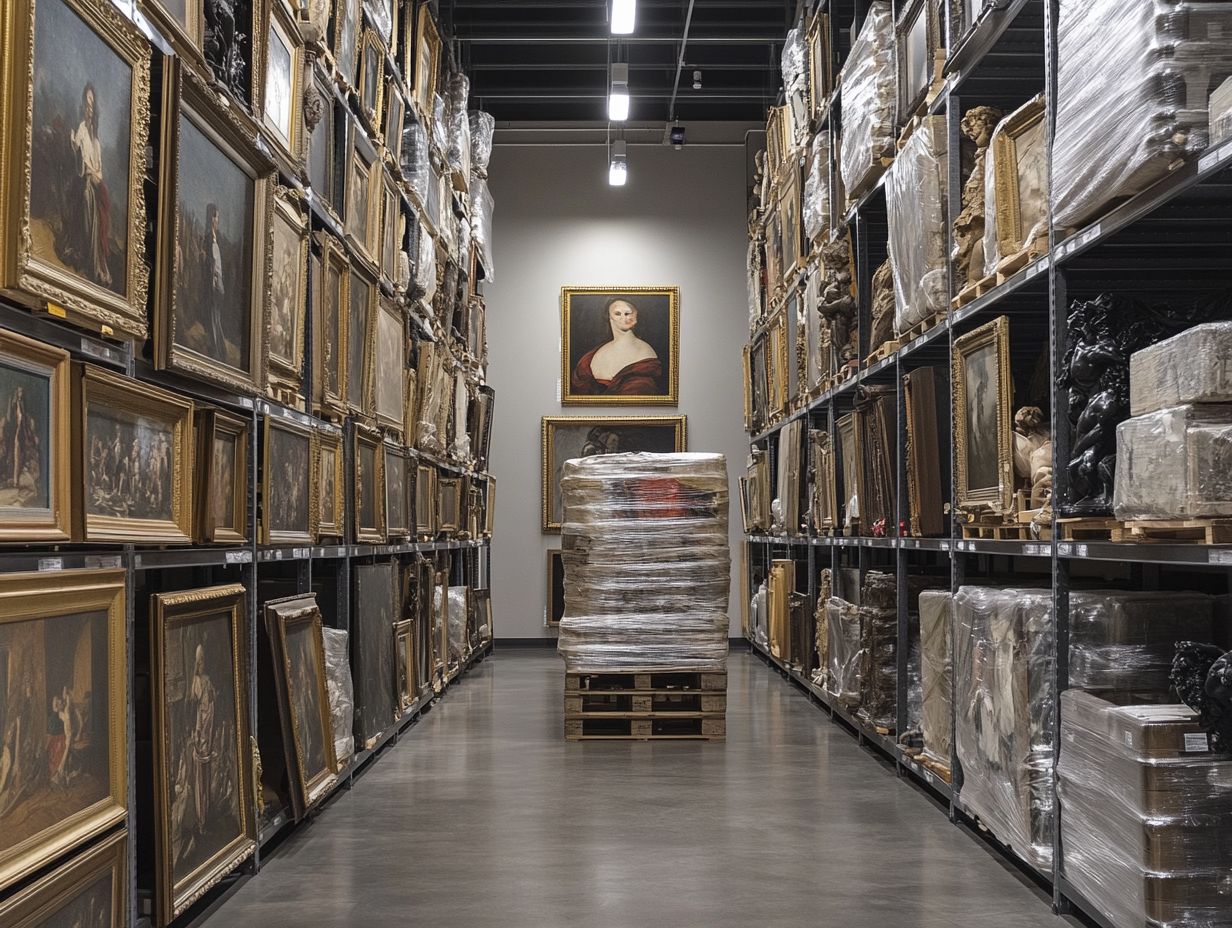10 Tips for Storing Your Art Collection
Storing your art collection with care is essential for preserving its beauty and value. Each piece, whether a priceless painting or a delicate sculpture, needs special attention.
Here are ten essential tips for art storage. These tips will guide you from selecting the right location to using protective materials.
Act now to protect your collection and keep it in stunning condition!
Contents
- Key Takeaways:
- 1. Choose the Right Location
- 2. Use Protective Materials
- 3. Avoid Direct Sunlight
- 4. Consider Temperature and Humidity Control
- 5. Keep Artwork Away from Heat Sources
- 6. Handle Artwork with Care
- 7. Use Acid-Free Materials for Framing
- 8. Keep Artwork Away from Moisture
- 9. Rotate Your Art Collection
- 10. Keep an Inventory of Your Collection
- How to Store Different Types of Artwork?
- Frequently Asked Questions
- What is the best way to protect my art collection from damage?
- What’s the best way to pack and move my art safely?
- What type of storage unit should I choose for my art collection?
- Is it important to keep an inventory of my art collection in storage?
- How can I prevent my art from getting damaged by pests and mold?
- What is the recommended way to store framed and unframed art pieces?
Key Takeaways:

Choose the right location to avoid damage from sunlight, heat, and moisture. Use materials that won’t harm your art when framing. Regularly rotate your collection and keep an inventory for proper preservation and organization.
1. Choose the Right Location
Choosing the right location is vital for protecting your art. Controlling temperature and humidity is essential.
A climate-controlled space not only protects your art but also increases its longevity and value.
Fluctuations in temperature and humidity can cause irreversible damage, like warping or fading. Aim for stable conditions ideal for all types of materials, whether canvas, wood, or paper.
Proper ventilation prevents harmful pollutants from accumulating. Specialized storage environments, like dedicated facilities, respect your investments and support the arts.
2. Use Protective Materials
Protective materials are crucial during storage and transport. They help keep your art in pristine condition.
Consider archival storage boxes to shield your pieces from light and dust. Using materials that won’t harm your art is also important.
Wrapping your art in breathable textiles or plastics gives extra cushioning against impacts. This reduces the risk of fading and damage, helping your art maintain its value.
Investing in museum-grade cabinets enhances safety and organization. This approach ensures your art can be enjoyed for generations.
3. Avoid Direct Sunlight
Direct sunlight can compromise your artworks, causing fading and deterioration. This is especially true for paintings and photographs.
Over time, UV exposure can lead to irreversible damage, diminishing value. To preserve their longevity, implement protective measures.
Using UV-filtering glass shields your art from harmful rays. Position your pieces away from sunlight or use curtains to reduce fading.
This will keep your cherished artworks vibrant for generations.
4. Consider Temperature and Humidity Control
Maintaining the right temperature and humidity is vital for your artworks. Even small changes can cause serious damage that affects their beauty and value.
For paintings, keep the temperature between 65 and 70 degrees Fahrenheit, with humidity at 40-60%. Textiles do best in cooler conditions with humidity around 30-50%.
Use tools like hygrometers, which are devices that measure humidity, and digital thermometers to monitor these levels. These devices provide real-time readings to help you protect your collection.
Investing in climate-controlled storage mitigates risks associated with extreme weather. This ensures future generations can enjoy your priceless pieces without the threat of deterioration!
5. Keep Artwork Away from Heat Sources
It s essential to keep your artworks away from heat sources to prevent warping, discoloration, or other damage that could jeopardize their integrity and value.
Many elements can generate unwanted heat in a typical environment, including direct sunlight through windows, radiators, heating vents, and warmth from electronic devices.
To effectively safeguard your art collection, position your pieces in areas with minimal sunlight. Consider using UV-filtering glass for framing as an extra layer of protection.
Proper ventilation in your storage spaces is crucial. It helps air flow, which regulates temperature and humidity levels. Using fans or dehumidifiers can reduce heat and moisture buildup, extending the lifespan of your cherished artworks!
6. Handle Artwork with Care

Handling artwork with care is essential to prevent accidental damage during transport or routine maintenance, ensuring the integrity of each piece remains intact.
As an art collector or enthusiast, you understand that the value of these creations goes beyond monetary worth; it includes their emotional and historical significance.
To protect those delicate features, use protective wraps like bubble wrap or foam when preparing pieces for movement. Wearing gloves is also smart to prevent fingerprints and oils from soiling surfaces, especially for paintings and photographs.
When lifting artworks, always carry them upright and avoid bending. Enlisting the help of another person or using a dolly can significantly enhance safety during transportation, minimizing the risk of slips or accidents!
Your attention to detail will ensure that your cherished pieces remain unharmed and ready to be appreciated for years to come.
7. Use Acid-Free Materials for Framing
Using acid-free materials for framing is essential to preserving the longevity of your artworks. The acidic components in standard materials can cause irreversible damage.
By choosing acid-free mats, backing boards, and glass, you create a protective environment that minimizes yellowing and deterioration over time.
These premium materials preserve the vivid colors and intricate details of your pieces while maintaining the overall aesthetic. When framing, use UV-filtering glass to provide an additional layer of protection against harmful light exposure!
Incorporating spacers between your artwork and the glass prevents direct contact, safeguarding those delicate surfaces. By adopting these best practices, you transform the framing process into a robust protective measure, ensuring that your valuable artworks can be enjoyed for generations to come.
8. Keep Artwork Away from Moisture
Keep artworks away from moisture. Damp environments invite mold and deterioration, threatening their condition.
Artwork types like paintings, sculptures, and textiles are especially vulnerable. Oils and watercolors can warp canvases, while humidity can make paper brittle or attract pests.
Use climate-controlled storage to maintain stable temperature and humidity. Incorporate moisture-resistant frames and acid-free storage boxes to guard against moisture.
These methods preserve your artwork and ensure it lasts for future generations.
9. Rotate Your Art Collection
Regularly rotating your art collection enhances its exposure and preserves artworks. This practice keeps your display fresh and captivating for visitors.
Plan a rotation schedule to represent diverse themes and narratives. Document visitor feedback or showcase seasonal highlights to make it effective.
Engage the community with workshops or discussions during each transition. This enriches appreciation and understanding of the art.
10. Keep an Inventory of Your Collection
Maintain an accurate inventory of your art collection for effective management. Track each artwork’s value, provenance, and condition easily.
This organized approach gives you peace of mind and assigns each piece a unique inventory number. This helps distinguish your artworks in a competitive market.
Record details like purchase value and selling price for informed decisions when selling or appraising.
Transparency is vital in art marketing; an organized inventory builds trust with potential buyers. It also protects against loss or damage, allowing for easier recovery or insurance.
How to Store Different Types of Artwork?
Understanding how to store different artwork types is key to preservation. Each piece needs specific care to remain in optimal condition.
Categorize art into forms like paintings, sculptures, textiles, and photographs. Each requires its own care protocols.
For example, paintings thrive in climate-controlled spaces to prevent damage from temperature changes. Sculptures may need special supports to avoid structural stress.
Follow professional art standards for storage. This approach protects the integrity and value of each piece.
What Are the Best Storage Options for Paintings?

Select the right storage options for your paintings to maintain their quality. Use protective wraps and archival methods to prevent damage.
Consider your artwork’s size, medium, and environmental needs. Store larger canvases vertically in climate-controlled areas to avoid warping. Smaller works on paper benefit from acid-free sleeves.
Wrap your paintings with materials like bubble wrap for extra cushioning. Archival boxes made from lignin-free materials ensure long-term preservation.
These strategies protect your artwork’s integrity and enhance its lasting beauty.
How to Properly Store Photography Prints?
Keep your prints safe by storing them in a cool, dark place! Properly storing your photography prints is essential. Start with using special boxes that don t damage photos to shield them from moisture and environmental factors that could cause fading and deterioration.
Incorporating acid-free materials is a smart move. This can significantly extend the lifespan of your cherished images.
A stable environment is vital. Aim for low humidity to prevent any potential damage from high temperatures or light exposure.
Organizing your prints for easy access is equally important. Consider categorizing them by date or event. This thoughtful organization not only preserves your work but also enhances the joy of revisiting the memories you ve captured.
What Is the Best Way to Store Sculptures?
Storing sculptures requires careful attention to environmental factors. A stable climate is essential for protecting them from humidity and temperature fluctuations.
Different materials have unique storage needs. For example, metal sculptures might require protective measures against rust. Wooden pieces must be shielded from moisture to prevent warping.
Provide ample space to avoid overcrowding, which can lead to scratches or breakage. Luxurious ceramic pieces and delicate glassworks thrive in a controlled environment.
This environment protects against pollutants, preserving each sculpture in optimal condition for years to come.
How to Store Artwork on Paper?
Storing your artwork on paper demands the use of acid-free materials and archival storage solutions. This prevents degradation and ensures longevity.
As an artist or collector, prioritize storage boxes made of archival-quality cardboard. Use acid-free tissue paper to interleave between pieces.
A stable environment is essential. Aim for controlled temperature and humidity levels, ideally around 70 F with 40-50% relative humidity. This helps mitigate the risks of mold and fading.
Minimize exposure to direct sunlight and pollutants. Consider storing your artwork in a dark, well-ventilated space to significantly enhance its preservation.
You should also use mylar sleeves or protective glass to shield your pieces from dust and mechanical abrasion, safeguarding their visual integrity for years to come.
What Are the Common Mistakes to Avoid When Storing Artwork?
Avoid common mistakes in art storage to safeguard both safety and value. This includes maintaining proper inventory systems and art care practices.
You may underestimate the importance of an organized inventory. Doing so can lead to confusion and potential loss of valuable artworks. Regularly check these systems to ensure all your pieces are accounted for.
Exposure to unsuitable temperatures or humidity can harm your art. Monitor the environment where your pieces are housed.
By implementing scheduled assessments, you can proactively tackle these issues. This ensures that your treasured items remain protected for generations to come.
Frequently Asked Questions
What is the best way to protect my art collection from damage?

The best way to protect your art collection is to store it in a climate-controlled environment with proper lighting and humidity levels. To enhance your knowledge, consider these 5 things every art collector should know. Avoid direct sunlight and extreme temperatures.
What’s the best way to pack and move my art safely?
When handling and transporting art, always use protective materials like acid-free paper and bubble wrap. Sturdy boxes are a must, and avoid stacking them to prevent damage.
What type of storage unit should I choose for my art collection?
Choose a storage unit with climate control and security measures like surveillance cameras and access codes. Ensure that the unit is clean and pest-free.
Is it important to keep an inventory of my art collection in storage?
Yes! Keeping an inventory of your art collection helps you track your pieces and their condition.
It’s also useful for insurance purposes in case of damage or theft. Act now to ensure your collection is safe!
How can I prevent my art from getting damaged by pests and mold?
Keep your art safe from pests and mold with these simple steps!
Regularly inspect and clean your storage unit. Use pest control measures and dehumidifiers to protect your art.
What is the recommended way to store framed and unframed art pieces?
For framed art, use special paper that won’t damage your art over time, along with bubble wrap to protect the frame and glass.
For unframed art, use archival quality folders or boxes to prevent any creases or damage.






